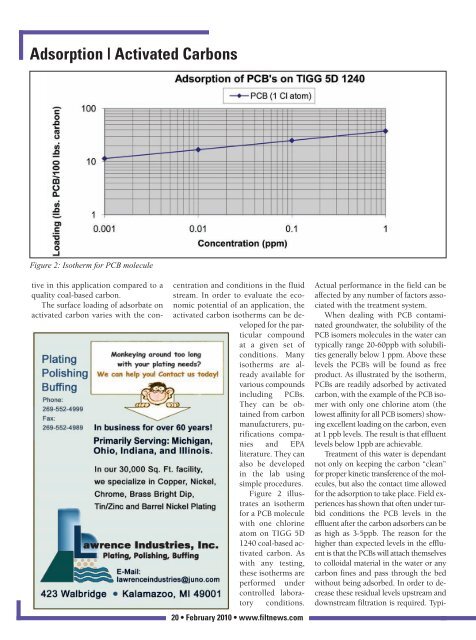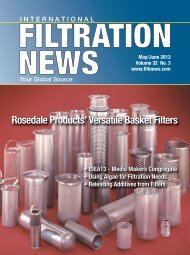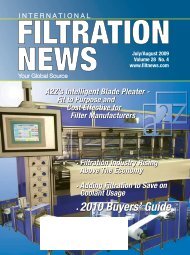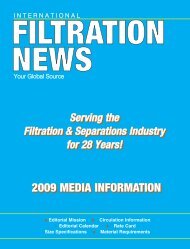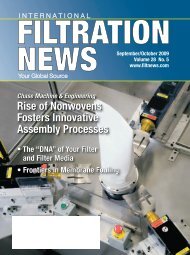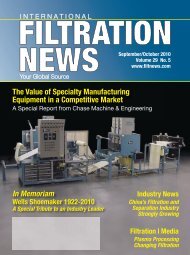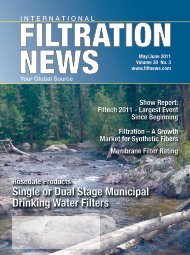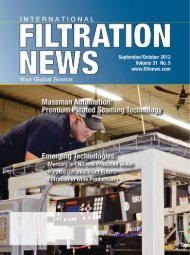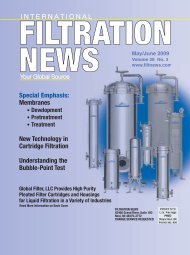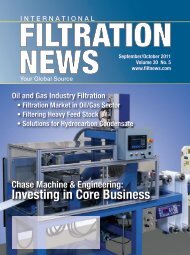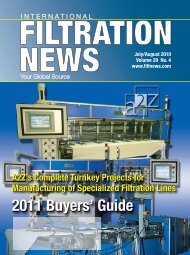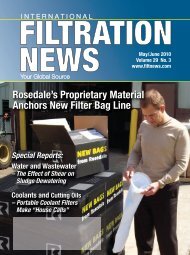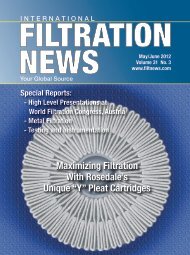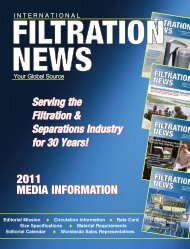Filter Media - Filtration News
Filter Media - Filtration News
Filter Media - Filtration News
You also want an ePaper? Increase the reach of your titles
YUMPU automatically turns print PDFs into web optimized ePapers that Google loves.
Adsorption | Activated Carbons<br />
Figure 2: Isotherm for PCB molecule<br />
tive in this application compared to a<br />
quality coal-based carbon.<br />
The surface loading of adsorbate on<br />
activated carbon varies with the concentration<br />
and conditions in the fluid<br />
stream. In order to evaluate the economic<br />
potential of an application, the<br />
activated carbon isotherms can be developed<br />
for the particular<br />
compound<br />
at a given set of<br />
conditions. Many<br />
isotherms are already<br />
available for<br />
various compounds<br />
including PCBs.<br />
They can be obtained<br />
from carbon<br />
manufacturers, purifications<br />
companies<br />
and EPA<br />
literature. They can<br />
also be developed<br />
in the lab using<br />
simple procedures.<br />
Figure 2 illustrates<br />
an isotherm<br />
for a PCB molecule<br />
with one chlorine<br />
atom on TIGG 5D<br />
1240 coal-based activated<br />
carbon. As<br />
with any testing,<br />
these isotherms are<br />
performed under<br />
controlled laboratory<br />
conditions.<br />
20 • February 2010 • www.filtnews.com<br />
Actual performance in the field can be<br />
affected by any number of factors associated<br />
with the treatment system.<br />
When dealing with PCB contaminated<br />
groundwater, the solubility of the<br />
PCB isomers molecules in the water can<br />
typically range 20-60ppb with solubilities<br />
generally below 1 ppm. Above these<br />
levels the PCB’s will be found as free<br />
product. As illustrated by the isotherm,<br />
PCBs are readily adsorbed by activated<br />
carbon, with the example of the PCB isomer<br />
with only one chlorine atom (the<br />
lowest affinity for all PCB isomers) showing<br />
excellent loading on the carbon, even<br />
at 1 ppb levels. The result is that effluent<br />
levels below 1ppb are achievable.<br />
Treatment of this water is dependant<br />
not only on keeping the carbon “clean”<br />
for proper kinetic transference of the molecules,<br />
but also the contact time allowed<br />
for the adsorption to take place. Field experiences<br />
has shown that often under turbid<br />
conditions the PCB levels in the<br />
effluent after the carbon adsorbers can be<br />
as high as 3-5ppb. The reason for the<br />
higher than expected levels in the effluent<br />
is that the PCBs will attach themselves<br />
to colloidal material in the water or any<br />
carbon fines and pass through the bed<br />
without being adsorbed. In order to decrease<br />
these residual levels upstream and<br />
downstream filtration is required. Typi-


